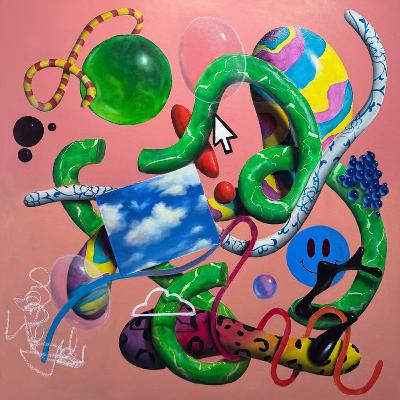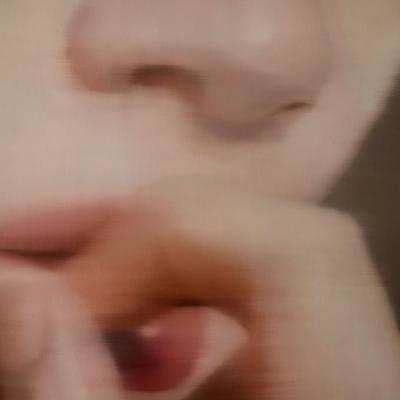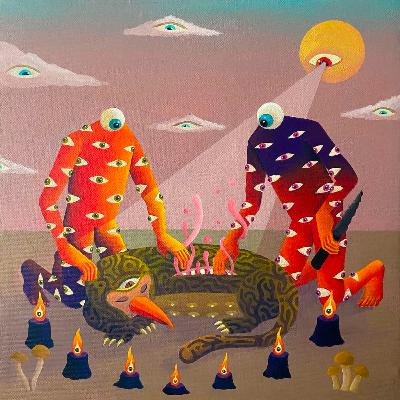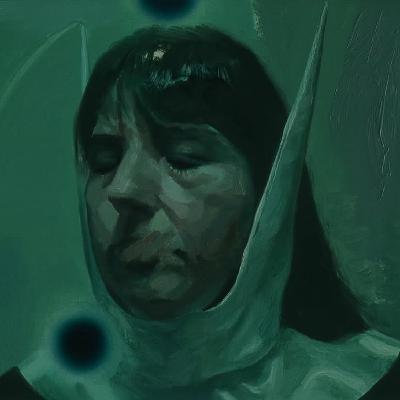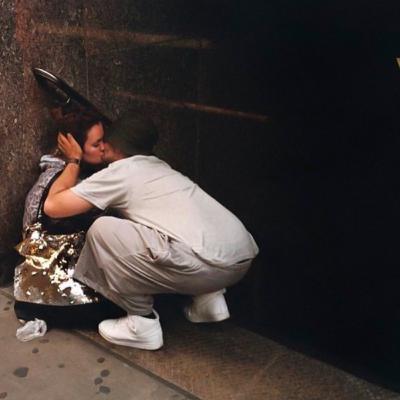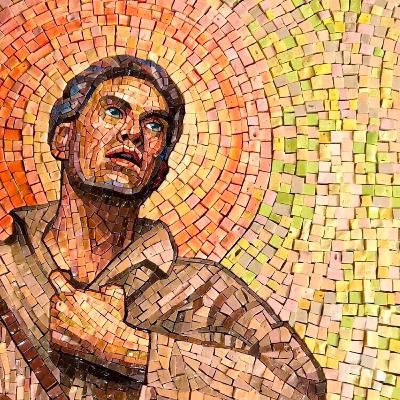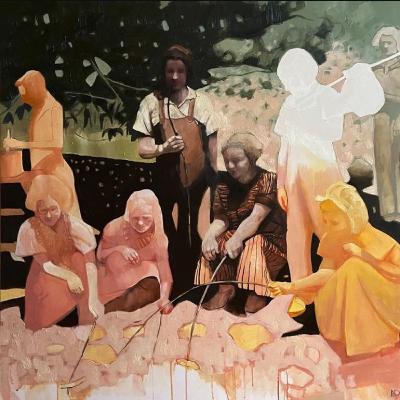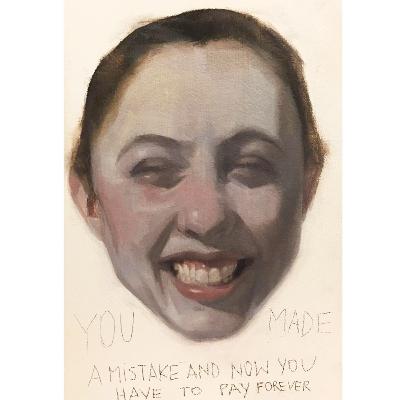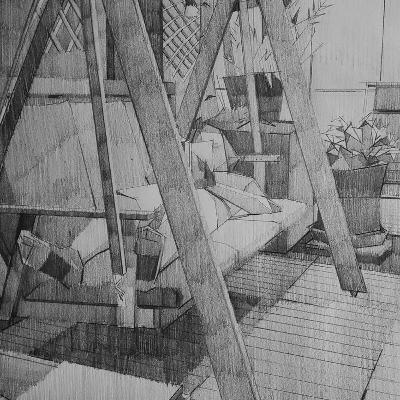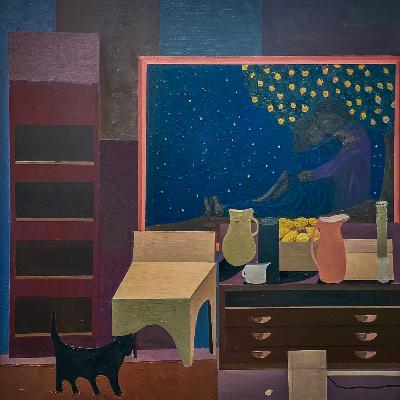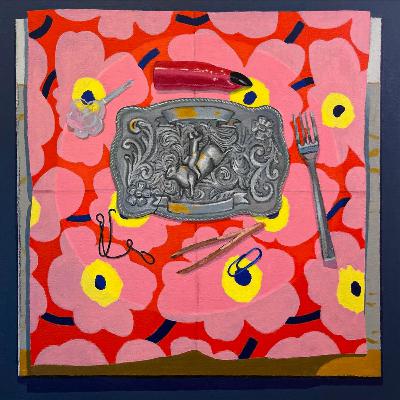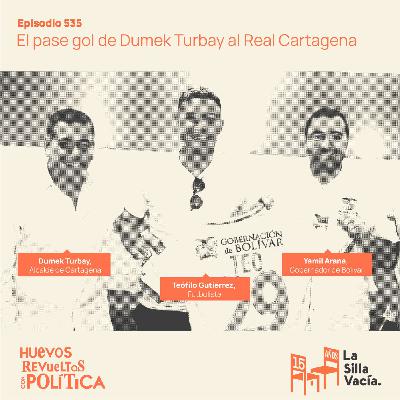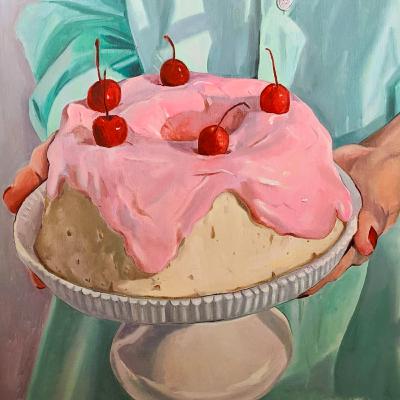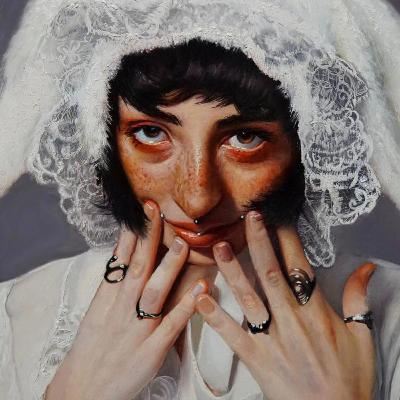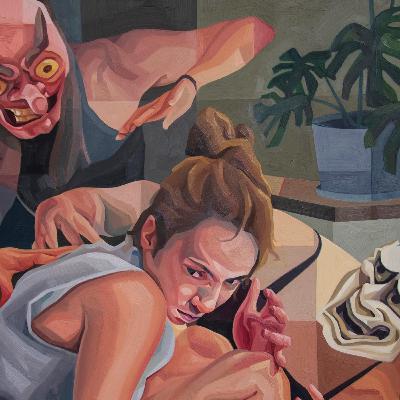Discover The Portraitists
The Portraitists

47 Episodes
Reverse
A conversation with Beau Carnes, an American figurative artist currently practicing in Denver, Colorado. Carnes grew up as an enthusiast of painters and paintings, however, dedicated himself to the pursuit of music, and later creative marketing. In both of these disciples, Carnes developed an appreciation for the execution of the intent via a process of technical know-how. Carnes was able to prove to himself that a craft could be learned and mastered if fundamentals were tediously studied and applied. At the age of 25, Carnes became refanaticized by paintings via frequent visits to the Minneapolis Institute of Art - and with spurring from his wife - Carnes decided to enter the practice himself. Carnes’ body of work depicts high octane fantasy - fun, surreal, and novel images that exist nowhere else besides Carnes’ imagination and canvas. Approaching painting, as his other outlets, Carnes utilizes the diligent and technical process of glazing - emulating the Old Masters he idolizes, and colliding centuries-old techniques with a modern visual subjective language. @beaucarnes
A conversation withJohanna Bath, a German figurative artist currently practicing in Hamm, Germany. After stumbling into visual art as a young adult, Bath’s life took a turn that suspended her from accessing both her true emotions and the potential of her full efforts. Bath would eventually liberate herself from these circumstances - dedicated to her practice, and dedicated to her authenticity. Bath’s work focuses on sensation, recollection, and the capture of ‘je ne sais quoi’. @fraeulein_bath
A conversation with Raul Sisniega, a Mexican figurative artist currently in residency in Roswell, New Mexico. Sisniega was raised in Mexico City - his parents spurred him to follow a straight and narrow path to white-collardom. Sisneiga’s relationship with his parent’s expectation and his artistic practice faced its reckoning in his mid-twenties, when he decided to drop out of law school and pursue an education in graphic design. This decision was still a concession, and finally, Sisniega’s impulse to create visual art in its purest form percolated forth in the form of wall painting that graffitied his apartment. Sisneiga was able to transition this private practice to a public practice by collecting these images with papers hung on his walls and plastering them to exteriors. This led to a decade spanning career in muralism, or as Sisneiga prefers: large scale illustration. Sisniega eventually cooled his muralism and pivoted to a more traditional practice, in which he’s able to connect directly to his globe-spanning collectors. Sisneiga’s work evokes the fundamental visual languages that threads prehistoric cultures, intersected by the aesthetic of a boy growing up in the 80’s with a Nintendo remote in hand, and exploring the internal angst that has teased him and us all.
@biosisniega
A conversation with Diego Zelaya, a Mexican figurative artist currently practicing in Mexico City. Zelaya had a unique upbringing - the 3rd and youngest son of revolutionaries-turned-scholars. Zelaya’s family highly prioritized education, and at the age of 16, Zelaya transplanted to a niche institution in the UK. While there, Zelaya’s interest in visual arts flourished amongst the collections of Britain. Zelaya was able to influence his academy to develop a more robust arts curriculum - including studio practice and tours to France. After 7 years abroad, Zelaya returned to Mexico City to start a new chapter of his artistic practice - muralism. These large-scale projects were as lucrative as they were dangerous - and that realization became bitterly clear after a tragic accident. Zelaya was inspired to shun his previous work, and retreat into the contemplative practice of studio art. Zelaya, steeped in a household of political consciousness, doesn’t describe his work as overtly political, but fundamentally political - as he strives to illustrate the internal of the human condition.
@diegozly
A conversation with Trevor Wisecup, a Virginian photographer currently practicing in New York City, New York. Wisecup grew up with an interest in visual arts, first captivated by the visuals and story-telling of video games. Wisecup’s aesthetic would be developed by a love for vintage artifacts - from VHS tapes, to thrifted suites, to analog cameras. After unintentionally relocating to New York city, a coincidence-of-sorts put the first rolls of film in his hands. Wisecup would continue forward documenting his life and observations with this alchemic media. Wisecup does not consider himself a street photographer, but instead a photographer at broad, recording any and all that he deems valuable - curious scenes from America’s largest public environment, or intimate glimpses from the cabin of a boat.
@trevorwisecup
A conversation with Itzamna Reyes, a Mexican figurative artist currently practicing in Mexico City. Reyes’ childhood dream of becoming an artist was supported by his family - particularly his grandmother who had a friendship with a career artist. From humble begins, to graduating art college, Reyes was evolving as quickly as Mexico City around him - yet his artistic focus was unclear. Reyes took an internship at a psychiatric clinic as an artistic recreation instructor - and each morning, on his long commute, Reyes was captivated by the concrete sprawl in which he traveled. Inspired by his study of documentarian street art - Reyes decided to record the ever changing environment of Mexico City’s barrios - and to represent them honestly - as Reyes states: gray.
@itzamnareyess
A conversation with Yasmine Elgamal, a Roman figurative artist currently practicing in Mecklenburg, Germany. Elgamal was introduced to studio art as a young student, and contrary to the pessimism of the peers of her working class suburb, was steadfast in her ambition to become an artist. Disillusioned with the philosophies of the academy system, Elgamal forged her own path - reading keystones of art method, and participating in unorthodox workshops - such as comic art courses to study traditional anatomy. Elgamal developed a traditional foundation through untraditional means, and now uses a somewhat familiar style to render the dramas and aesthetics of her contemporary life - a life consumed by the feedback loops of a painter.
@_yasmine_elgamal_
A conversation with Ramiro Sanchez, an Venezuelan multidisciplinary artist currently practicing in Florence, Italy. Sanchez began his creative career as a gifted music student, participating in choir and the viola at a selective Jesuit school in Venezuela, Niños Cantores del Zulia. Inspired by the rich practice of Latin-American muralism, Sanchez pivoted to visual arts at the age of 13. Through extreme determination, and with only a gifted plane ticket, Sanchez relocated to study at Accademia di Belle Arti in Florence at the age of 19. Sanchez continued his education at the Florence Academy of Art, where he was invited to profess, and is now the Director of the Advanced Painting Program. Sanchez is currently in final years of a decade-spanning commission - the adornment of Saint Bede Catholic Church, is Williamsburg, Virginia.
@ramirosanchez_art
A conversation with Amy Dury, an English figurative artist currently practicing in Brighton, England. Dury’s art education was detoured in her youth, but through a series of adventures Dury graduated from her preferred Glasgow School of Art with a degree in printmaking. Like many artists, Dury’s art career was suspended by the responsibilities of parenthood and sourcing a stable income, but when Dury saw the opportunity to teach painting at Varndean College in Brighton, England - she reignited her practice with extreme focus. Dury’s foundation in printmaking can be seen in her work as her paintings are rendered with defined blocks, experimental textures, and an overall graphic quality. Dury’s focus on historical photography has spurred her to explore archival video - snapshotting the frames she finds most interesting - straddling the line between photographer and time traveler.
A conversation with Aysha Nagieva, a Russian-born artist living and practicing in London, England. Nagieva spent her early girlhood in Moscow, discomforted by the rigidity of the traditional Russian artistic expectation. After transplanting to London, Nagieva’s interest in unfettered expression and fashion design developed into an artistic practice that nods to her Russian roots, while expanding beyond the boundaries of the academy. Nagieva hijacks the motif of the russian doll - transplanting it from its traditional origins into a contemporary and cheeky universe. Playfully, Nagieva breaks all the rules that intimidated her as a girl - and through her body of work an expansive self portrait emerges.
@aysha.nagieva
A conversation with Lorenna Lannes, a Brazilian figurative artist practicing in New York, New York. Lannes’ work focuses primarily on capturing and exploring the impression of covert signals of emotion and intention - the “energy” a person emits beneath verbal and physical language. To paraphrase Lannes’ description - these sub-physical signals are the most honest, and learning to interpret them can be of great utility - no more so than keeping yourself safe.
@lorennalannes
A conversation with Luke Hannam, an English figurative artist based in Rye, England. Hannam is a multidisciplinary artist - raised with a foundation in improvisational jazz - Hannam’s drawing and painting practice resemble this ‘ordered chaos’. Hannam is deeply interested in timeless motifs - the warrior, the fertility goddess; the dove of peace. As Hannam describes, the dove’s flight - it’s strength and ability - emerges from its delicacy – as so does Hannam’s images - which convey power with economic, decisive lines.
@lukehannampaintings
A conversation with Sonja Haroldson, an American figurative artist based in New York City, and currently at residence in Wilton, Connecticut. Haroldson is a multidisciplinary artist whose output spans music, sculpture, drawing, and painting. Haroldson’s two dimensional work manifests in a style similar to architectural drafting - graphic lines, economic blocking, and simplified palettes - with energetic marks and muscular impasto. Harldson’s quasi-brutalist and cerebral fashion is curiously balanced with her preferred subject of tranquil and mundane scenes of apartment-dwelling and urban life.
@sonjaharoldsonart
A conversation with Jaron Gyger, a Swiss figurative artist currently practicing in Berlin, Germany. Gyger’s practice acts as a type of journal, illustrating life experiences or emotional anecdotes. Gyger’s works are rendered in a style that lands in the intersection of kinetic abstraction, cubism, and figurativism. Gyger’s images take an unabashed approach to genuinity, prioritizing honesty and communication over politeness or popularity.
@jaron_gyger
A conversation with Kuda Mushangi - born Zimbabwe, and raised in England - Mushangi is a figurative artist currently practicing in London, England. Mushangi immigrated to the UK with his family at the age of 9. Now a practicing architect, Mushangi rediscovered his boyhood passion for visual art as an escape from the rigidity of his career and its requirements. Mushangi is a relatively new painter, and his debut project is conjuring and recording the vague and vanishing memories of his early youth in Zimbabwe. Like all childhood memories, Mashangi’s scenes balance innocence, confusion, and disproportionality - all while rendered in a style that nods to a childlike interpretation.
@kuda.mushangi
A conversation with Kate Powell, an American multi-disciplinary artist currently practicing between Tacoma, WA and Philadelphia, PA. Powell is a member of the Pennsylvania Academy of the Fine Arts’ low-residency MFA class of 2024.
Powell’s creative output spans music, sculpture, drawing, and painting. Powell’s subjects span portraiture, first-person observation, and still lifes of found objects. Binding this frenzy of work, a thread of jovial curiosity and intense feeling.
@katepowellartist
A conversation with Matt Murphy, an English portrait painter currently practicing in Brighton, England. After a childhood fascination with art, and graduating A-Levels, Murphy took a long-term hiatus from his practice. While living in Vietnam, marooned by the Covid Pandemic, Murphy began working with the regionally popular media, water colors. This new media inspired a different process, which carried onto Murphy’s work with oils. Red and gazing, Murphy’s subjects appear through the flowing, loose marks.
@mattmurphyart
A conversation with Debora Koo, a Korean-American figurative painter currently practicing in Charlotte, North Carolina. Koo received her B.A at Smith College in Massachusetts, and her M.F.A. from Ewha University in Seoul, Korea. Koo’s work explores themes of otherism, romantic despair, and nostalgia. Koo’s iconic cake paintings offer a sense of indulgence and familiarity that pull the viewer into a sensatory memory like a kept polaroid. Koo's work has been exhibited in Ulsan, Korean, London, New York City, and Charlotte.
@deb_koo
A conversation with Cory Swenson-Scott, an American figurative painter practicing in California and abroad. Swenson-Scott received his Master of Fine Art from the Academy of Art University in San Francisco, and has collected an expansive series of accolades in the California area, including a repeat annual showcase at the Crocker Art Museum in Sacramento. Swenson-Scott has been awarded various residencies which allow him to practice in destinations such as Sweden, Mexico, and Japan. Both at home, and abroad, Swenson-Scott’s practice involves the identification and representation of those who are not typically portrayed in fine art - which is particularly elevated through the artist's traditional style and application. This includes those of uncommon fashion, social outcasts, and persons who would otherwise not have the opportunity - as is the case in Swenson-Scott’s series of rural Japanese folk.
A conversation with Stelios Pupet, a Greek figurative artist that practices in Athens, Greece. Pupet developed his artistic practice as a young graffiti artist running from the authorities in the Athenian Metro. Pupet retained these foundations as he evolved into his fine art practice. Pupet depicts the human form, often female, often obscured or masked, or tranquil in an urban/suburban gardenscape. Pupet’s recent signature is his style of rendering in bold rigid shapes, capturing a moment as it freezes into 8-bit.


